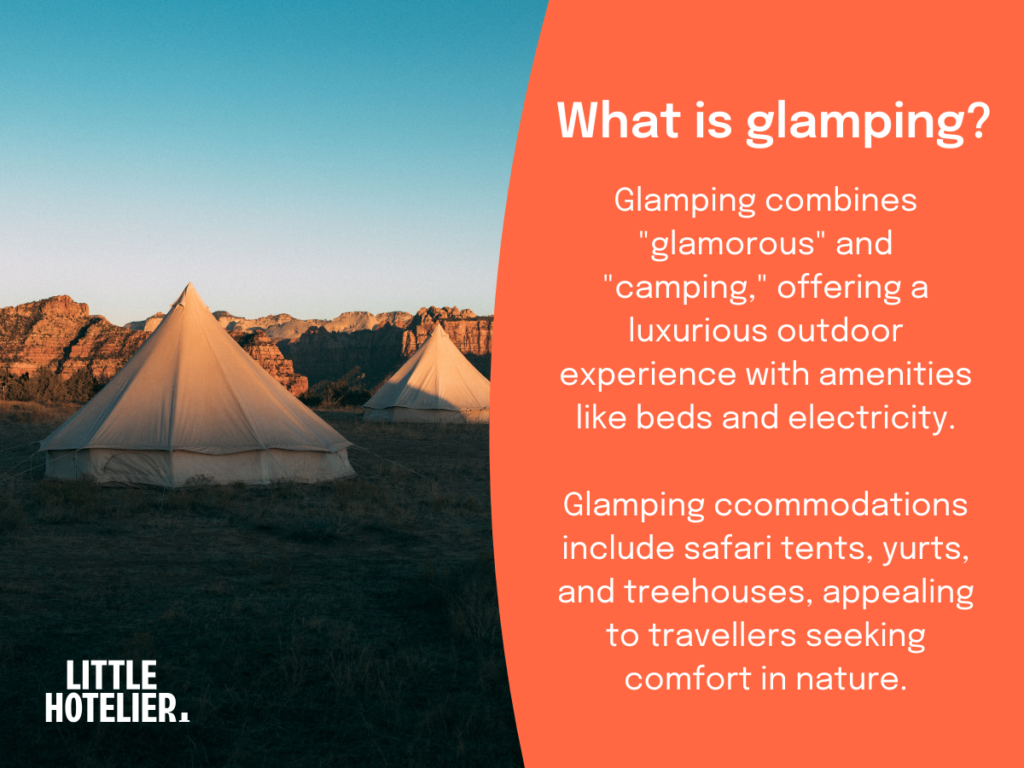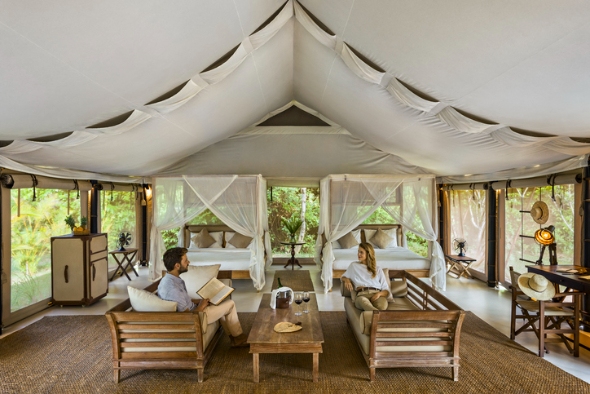What is glamping?
Glamping, short for “glamorous camping,” is an elevated camping experience that blends the rustic charm of the outdoors with the comfort and convenience of modern amenities. It might include staying in luxury tents, treehouses, or cabins outfitted with comfortable beds, private bathrooms, and even Wi-Fi. Glamping gives travellers a chance to connect with nature without giving up the comforts of home.
This growing travel trend is becoming a favourite for eco-conscious travellers, families, and adventure seekers.
In this article, we’ll show you how, for small property owners, glamping is a fantastic opportunity to diversify offerings and boost revenue.
Difference between glamping and camping
The key difference between glamping and camping lies in the level of comfort and convenience. Traditional camping often involves setting up tents, sleeping in sleeping bags, and cooking over a campfire. Glamping, on the other hand, offers fully set-up accommodations, often including luxury features like climate control, en-suite bathrooms, and curated experiences like stargazing or guided tours. Essentially, glamping combines the best of both worlds: outdoor adventure and a premium stay. In many ways, it’s similar to the difference between a hotel and a resort.
Streamline your glamping business with Little Hotelier
Simplify bookings, showcase your accommodations with stunning listings, and boost revenue with dynamic pricing tools - all from one location.
Learn moreWhy is glamping becoming more popular?
Glamping has gained immense popularity in recent years, appealing to a diverse range of travellers. Guests are drawn to its promise of immersive outdoor experiences paired with modern comforts. Eco-conscious travellers love glamping’s sustainability focus, while families and couples appreciate the opportunity to escape into nature without sacrificing convenience. For small hotels and property owners, glamping taps into this growing demand for unique, memorable stays.
What does glamping mean for small accommodation businesses
For small accommodation businesses, glamping is a chance to stand out in a competitive market. By incorporating glamping, property owners can attract new traveller segments, extend their seasonal offerings, and command higher rates for unique experiences.
This not only can boost your average daily rates with premium outdoor accommodations, but also strengthen your hotel’s unique value proposition by tapping into the growing demand for personalised, nature-driven experiences.
Types of glamping sites
Glamping accommodations come in many forms, each with its own unique appeal. Here are some popular options to consider for your property:
1. Yurts and domes
Yurts and geodesic domes provide spacious, round interiors ideal for creative layouts. They’re durable, eco-friendly, and highly customisable, making them a popular choice for glamping enthusiasts.
2. Glamping tents
Luxury tents combine the charm of traditional camping with the added comfort of real beds, private decks, and stylish décor. Safari tents and bell tents are common options, offering a touch of adventure with high-end features.
3. Treehouses
Treehouses are perfect for guests seeking something truly out of the ordinary. Suspended in nature, they provide a sense of adventure while including premium amenities like heating, private bathrooms, and scenic views.
4. Glamping pods
Compact and efficient, glamping pods are versatile accommodations that work well for smaller spaces. Often pre-fabricated, these pods can be easily installed and offer modern comforts like insulation, electricity, and en-suite facilities.
5. Cabins and cottages
For a more traditional feel, rustic cabins or modern cottages give guests a home-like experience surrounded by nature. These options are great for year-round use and can be designed to cater to families, couples, or groups.

How to implement glamping in small properties
Bringing glamping to your property doesn’t have to be complicated. Here are the key steps to get started:
Consider finances and ROI
Adding glamping accommodations can be a profitable investment, but it’s important to plan your budget carefully.
The initial costs can include purchasing tents, domes, or pods, obtaining permits, and installing utilities like electricity or plumbing. Maintenance and marketing expenses should also be factored into your budget.
Research your competitors, learn from your peers, and dig into local demand to set rates that reflect the value of your glamping experience. Offering tiered pricing for different accommodation types, such as premium tents with private hot tubs, can appeal to a broader audience.
Set up glamping accommodations
Designing and setting up glamping spaces involves both creativity and practicality.
Begin with research into market demand and local competition. Check zoning regulations and secure permits for your glamping site. Plan your layout to make the most of your property’s natural features, such as scenic views or secluded spaces.
Focus on guest comfort and visual appeal. Include high-quality bedding, cosy seating areas, and thoughtful details like string lights or natural décor. Make the spaces “Instagram-worthy” to attract attention online.
Ensure your accommodations meet modern traveller expectations. Wi-Fi, private bathrooms, climate control, and eco-friendly features like solar panels or composting toilets are increasingly seen as essential for a premium glamping experience.
Promote your glamping experience
Marketing is key to positioning your glamping property as a must-visit destination.
Share high-quality photos and videos of your glamping accommodations on Instagram, Facebook, and Pinterest. Partner with travel influencers to showcase your property authentically and reach their engaged audiences.
Use platforms like Airbnb and Google Hotel Ads to list your glamping offerings. Highlight unique features, such as stunning views, luxury touches, or adventure packages, and use professional photography to make your listings stand out.
It’s important to offer packages that combine glamping with experiences like private dining, spa treatments, or local tours. For example, a glamping site in a wine region might pair stays with vineyard tours and tastings, creating a memorable and value-added experience for guests.
Optimise operations and maintenance
Smooth operations and excellent upkeep are essential for long-term success in glamping.
First, regularly inspect and clean your tents, domes, or cabins to ensure they remain in excellent condition. Be proactive in addressing weather-related wear and tear.
Next, actively encourage guests to share feedback during their stay. Use their suggestions to improve amenities and experiences, showing that you value their input. This builds loyalty and attracts positive reviews.
Many hotels choose to adopt app-based check-ins and digital concierge services to streamline guest interactions and minimise manual work for your staff. Little Hotelier’s all-in-one booking platform is an excellent tool for managing glamping reservations and optimising operations.
Glamping trends according to campers
The glamping industry is evolving, shaped by the preferences of modern campers. Here are some trends driving its growth:
- Sustainability: Travellers are prioritising eco-friendly stays, with an emphasis on renewable materials and low-impact designs.
- Wellness experiences: Offerings like yoga retreats, spa treatments, and nature-based activities are becoming increasingly popular.
- Themed glamping: Unique themes, such as stargazing pods or adventure hubs, help properties stand out and attract niche audiences.
By Dean Elphick
Dean is the Senior Content Marketing Specialist of Little Hotelier, the all-in-one software solution purpose-built to make the lives of small accommodation providers easier. Dean has made writing and creating content his passion for the entirety of his professional life, which includes more than six years at Little Hotelier. Through content, Dean aims to provide education, inspiration, assistance, and, ultimately, value for small accommodation businesses looking to improve the way they run their operations (and live their life).
Table of contents
“With the mobile app, you can run your business from wherever. It's incredibly user-friendly and straightforward. Little Hotelier also offers 24/7 customer service.”
Owner, Sundowner Twin Towns Motel









Atte,
Owner
Lake Enari Mobile Cabins